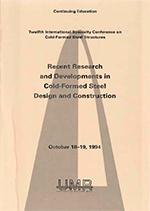Location
Saint Louis, Missouri
Session Dates
18 Oct 1994
Abstract
The primary goal of the subject study was to investigate the behavior and load capacity of stub columns using cold-reduced, low-ductility steel versus un-reduced, normal-ductility steel. Specimens that were cold-reduced were also welded transversely across the entire stud cross section. Therefore, this study also yielded data with regard to the axial performance of welded studs. In addition, since stub columns were punched and un-punched, further conclusions can be drawn about the effect of a weld located at a web perforation. A total of 133 stub column tests were performed at the Dietrich Material Testing Laboratory in Hammond, Indiana, between December 14 and December 20 of 1993, and on January 27 of 1994. Tests were conducted using two procedures. The first test procedure used a track at each end of the stub column. The second test procedure did not use a track. Grouting or welding was not used in either test procedure. There was no need for special end preparations since specimens were cut with very close tolerances regarding end squareness. From the test data the following conclusions can be drawn. First, the presence of a weld in a stud had no effect on the stub column load capacity. Second, the presence of a weld at a knockout had no effect on the stub column load capacity. Third, reduced stub columns fared very favorably in load capacity when compared to the 1986 AISI specification as long as 75 percent of the yield strength is used per AISI Specification, Section A3.3.2. Fourth, it is recommended that Section A3.3.1 of the AISI Specification be changed to include steel having Fᵤ/Fᵧ ratios of 1. 01, elongations in a 2 in. gage length of three percent, and elongations in a 1/2 in. gage length of ten percent.
Department(s)
Civil, Architectural and Environmental Engineering
Research Center/Lab(s)
Wei-Wen Yu Center for Cold-Formed Steel Structures
Meeting Name
12th International Specialty Conference on Cold-Formed Steel Structures
Publisher
University of Missouri--Rolla
Document Version
Final Version
Rights
© 1994 University of Missouri--Rolla, All rights reserved.
Document Type
Article - Conference proceedings
File Type
text
Language
English
Recommended Citation
Daudet, L. Randy and Klippstein, K. H., "Stub Column Study Using Welded, Cold-reduced Steel" (1994). CCFSS Proceedings of International Specialty Conference on Cold-Formed Steel Structures (1971 - 2018). 5.
https://scholarsmine.mst.edu/isccss/12iccfss/12iccfss-session5/5
Stub Column Study Using Welded, Cold-reduced Steel
Saint Louis, Missouri
The primary goal of the subject study was to investigate the behavior and load capacity of stub columns using cold-reduced, low-ductility steel versus un-reduced, normal-ductility steel. Specimens that were cold-reduced were also welded transversely across the entire stud cross section. Therefore, this study also yielded data with regard to the axial performance of welded studs. In addition, since stub columns were punched and un-punched, further conclusions can be drawn about the effect of a weld located at a web perforation. A total of 133 stub column tests were performed at the Dietrich Material Testing Laboratory in Hammond, Indiana, between December 14 and December 20 of 1993, and on January 27 of 1994. Tests were conducted using two procedures. The first test procedure used a track at each end of the stub column. The second test procedure did not use a track. Grouting or welding was not used in either test procedure. There was no need for special end preparations since specimens were cut with very close tolerances regarding end squareness. From the test data the following conclusions can be drawn. First, the presence of a weld in a stud had no effect on the stub column load capacity. Second, the presence of a weld at a knockout had no effect on the stub column load capacity. Third, reduced stub columns fared very favorably in load capacity when compared to the 1986 AISI specification as long as 75 percent of the yield strength is used per AISI Specification, Section A3.3.2. Fourth, it is recommended that Section A3.3.1 of the AISI Specification be changed to include steel having Fᵤ/Fᵧ ratios of 1. 01, elongations in a 2 in. gage length of three percent, and elongations in a 1/2 in. gage length of ten percent.



